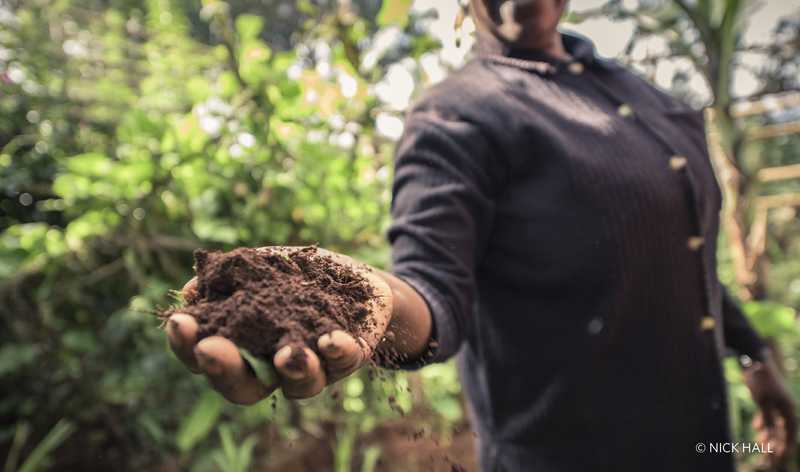
Wednesday 2nd December 2020 — A powerful new mapping tool in the race to mitigate runaway climate change by harnessing the full carbon-sequestering potential of the ground beneath our feet was unveiled today.
Wednesday 2nd December 2020
Soils Revealed platform aggregates scientific data to provide global policymakers with access to 11,000 years of carbon records and projected future climate mitigation potential.

A powerful new mapping tool in the race to mitigate runaway climate change by harnessing the full carbon-sequestering potential of the ground beneath our feet was unveiled today.
This is important as a study, published in Nature Sustainability showed that soils are collectively capable of delivering one-quarter of the total contribution of natural climate solutions (NCS) toward absorbing atmospheric carbon.
Soils Revealed is a fully interactive, open-access platform that utilises sophisticated machine-learning technology to combine an unprecedented richness of historic global soil data with projections for future carbon-storing capacity. It was designed by scientists from The Nature Conservancy, Cornell University, Woodwell Climate Research Center and ISRIC – World Soil Information.
Using this tool, policymakers, land managers and NGOs can pinpoint areas where restoring soil carbon will have maximum impact on meeting national and regional climate goals.
“Soils have a vital role to play in mitigating climate change and supporting biodiversity, but to date we’ve tended to view them too much in static terms,” explains project lead Dr Deborah Bossio, Lead Soil Scientist for The Nature Conservancy.
“One of our goals with this launch is to remind policymakers that these complex, millennia-old ecosystems are every bit as dynamic as forests – and every bit as capable of recovery, if the right management practices are prioritised. We already know how to do this – now Soils Revealed can show us where to focus these efforts.”
Using the platform, land managers are able to mark-out boundaries around a specific area of land at country or regional level and reveal how sequestered carbon stores have fluctuated over time – a first for platforms of this type.
“The Soils Revealed platform allows policy makers to get a better understanding of the stunning decrease of carbon in our soils since we started farming,” says Rik van den Bosch, director of project partner ISRIC – World Soil Information. “And, even more important, the platform also shows where the greatest potential exists to store more carbon in the soils and thus decrease the impact of climate change.”
Of the total potential of soil, 5.5 Gt of CO2-equivalent per year in soil organic carbon. It’s calculated that 40% would come from protection of existing soil carbon stores in wetlands, forests and grasslands, with the other 60% being contributed by rebuilding depleted stocks much of it in agricultural soils.
“This innovative platform delivers immense opportunities of soils to remove atmospheric carbon dioxide at your fingertips. We hope that policy makers and industry get to work and explore where they can help to restore our soils with carbon and mitigate climate change,” added Johannes Lehmann, co-leading project investigator, Liberty Hyde Bailey Professor of Soil Biogeochemistry in Cornell University’s College of Agriculture and Life Sciences, and a faculty fellow at the Cornell Atkinson Center for Sustainability.
Editors notes
“The Nature Conservancy (TNC) is a global conservation organisation dedicated to conserving the lands and waters on which all life depends. Guided by science, we create innovative, on-the-ground solutions to our world’s toughest challenges so that nature and people can thrive together. We are tackling climate change, conserving lands, waters and oceans at an unprecedented scale, providing food and water sustainably and helping make cities more sustainable. Working in 72 countries, we use a collaborative approach that engages local communities, governments, the private sector, and other partners. To learn more, visit www.nature.org or follow @nature_press on Twitter.
Cornell University College of Agriculture and Life Sciences is a pioneer of purpose-driven science and home to Cornell University’s second largest population of students, faculty and staff. We work across disciplines to tackle the challenges of our time through world-renowned research, education and outreach. The questions we probe and the answers we seek focus on three overlapping concerns: natural and human systems; food, energy and environmental resources; and social, physical and economic well-being. Visit us at https://cals.cornell.edu/ and @CornellCALS on Twitter. Learn more about the Cornell Atkinson Center for Sustainability online and on Twitter at @AtkinsonCenter.
ISRIC – World Soil Information is an independent foundation which collaborates globally to make reliable and relevant soil data freely available. We are a custodian of global soil information which we produce, gather, compile, assess and serve to international science and policy communities as well as the private sector. We believe quality-assessed soil data will help the world make progress on issues related to food production, land and water management, climate change, environmental quality, social justice, land use planning, and biodiversity. We are based on the campus of Wageningen University and Research in the Netherlands. To learn more, visit www.isric.org or follow @ISRICorg on Twitter.
Woodwell Climate Research Center is an organization of renowned researchers who work with a worldwide network of partners to understand and combat climate change. We bring together hands-on experience and 35 years of policy impact to find societal-scale solutions that can be put into immediate action. Woodwell Climate has earned Charity Navigator’s highest rating of 4 stars, as well as a Gold Seal of Transparency from GuideStar. Follow us on Facebook, Twitter and Instagram or subscribe to our monthly newsletter.